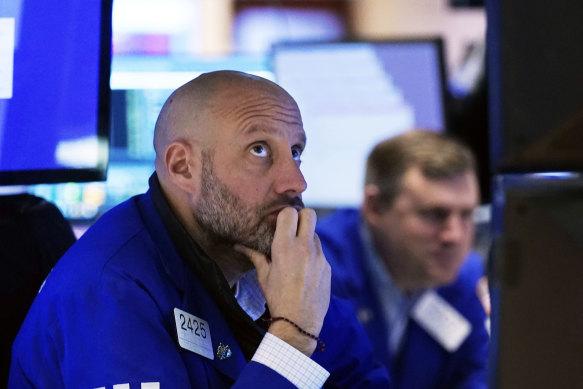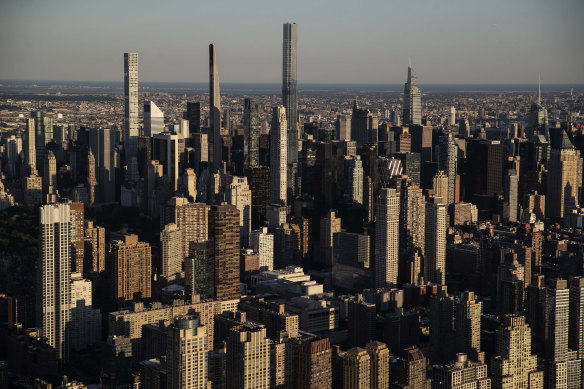This was published 2 years ago
Opinion
What dangers are lurking in the shadows of the global financial system?
Stephen Bartholomeusz
Senior business columnistWhen central banks raise interest rates rapidly and suck liquidity out of the financial system, “things” – US regional banks, UK pension funds, property markets – break. The multitrillion-dollar question is whether there are more of those things lurking within the shadows of the system.
There have been a number of events over the past year that point to the increasing vulnerability of the system.

The global financial system is looking increasingly vulnerable. Credit: AP
Last year the widespread use of a leveraged derivatives strategy designed to hedge UK pension fund liabilities almost blew up the sector when the then-UK prime minister Liz Truss and her chancellor, Kwasi Kwarteng, announced a radical new fiscal strategy.
The UK bond market revolted, yields on government bonds soared, the funds were hit by what were effectively margin calls on their derivate positions, and it took large-scale intervention by the Bank of England (and the abandonment of the Truss budget and a change of PM and chancellor) to avoid a financial catastrophe.
Late last year, there was another major warning sign of systemic pressure when the world’s largest fund manager, Blackstone, began rationing redemptions from its $US71 billion ($106.6 billion) Blackstone Real Estate Income Trust after being hit with a flood of redemption requests. Other international property fund managers have also had to restrict withdrawals.
Then, this year, there were the runs on US regional banks that saw three sizeable banks fail and deposits flow out of that sector towards the big Wall Street banks and money market funds.
The common elements in each of these events are the combination of rising rates and shrinking liquidity.
For the pension funds, selling bonds in an environment where bond yields were spiking and their value slumping (there is an inverse relationship between yields and the value of fixed rate bonds) to meet their margin calls would have torn holes in their balance sheets.
For the property funds, allowing some investors to exit in an environment where real estate values were starting to fall under the weight of the rate rises would have exacerbated the losses for those who weren’t selling. Fire sales of assets to meet redemptions would exacerbate the losses.
Similarly, for the US banks – and Credit Suisse – the rise in rates effectively devalued their portfolios of held-to-maturity government securities while liquidity mismatches meant that they couldn’t generate enough cash to meet redemptions without suffering massive, institution-ending losses in the process.

Commercial property has the wobbles.Credit: Bloomberg
It would be a pleasant but unlikely surprise if that combination of rapidly rising interest rates – to levels not experienced in decades – reduced liquidity and pressure on asset prices didn’t produce more casualties.
There are banks sitting on tens of billions of paper losses, and in some instances realised losses, from leveraged lending for corporate buyouts like Elon Musk’s acquisition of Twitter.
More consequential is the pressure on commercial real estate values being experienced in much of the developed world through the combination of higher interest rates, less liquidity and thanks to the pandemic, lower occupancy rates because of the working from home phenomenon. Slowing economic growth, even recessions, will add to that pressure.
With about $US1.5 trillion of commercial property needing to be refinanced in the US alone over the next 18 months or so, and most commercial property lending in the US done by regional and local banks, a significant decline in values has the potential to ignite a new bout of financial stress.
Banks, because of the reforms enacted in response to the 2008 financial crisis, hold a lot of capital and liquidity and, as the recent collapses in the US and the forced merger of Credit Suisse with UBS demonstrated, regulators respond quickly to any sign of distress in the banking sector to head off wider systemic instability.
That substantial increase in the capital and liquidity requirements for banks post-2008, however, has resulted in the dramatic growth in the assets of non-bank institutions.
The International Monetary Fund has put the non-bank share of total global financial assets at almost 50 per cent. In 2008, according to a recent Federal Reserve Bank of New York paper, that share was just above 40 per cent.
The non-banks, or “shadow banks” as they are sometimes called, don’t face the capital or liquidity requirements of regulated banks nor are their activities as transparent. The IMF has said there is little regulatory or supervisory oversight of these non-banks and that they have “virtually no loss-absorbing capital”.

A spate of US bank collapses rattled the global banking system. Credit: AP
The non-bank sector includes pension or superannuation funds, insurers, hedge funds, private equity funds, private credit funds and many other entities, often pursuing leveraged strategies.
Unlike banks, there aren’t depositors at risk in non-banks but widely dispersed cohorts of risk-taking investors, so the direct implications of distress in that sector for financial system stability aren’t as significant as bank failures. There may, however, be indirect implications.
The NY Fed paper said non-banks “naturally interact” with banks in many markets and banks could develop significant direct exposures from their counterparty relationships.
Banks, for instance, often rely on non-banks for short-term liquidity through “repo” arrangements under which they sell government securities with an agreement to buy them back at a slightly higher price. As was experienced in 2020, when that repo market froze and the Fed had to intervene, stresses within the non-bank sector can cut off banks’ access to instant liquidity.
It would be a pleasant but unlikely surprise if that combination of rapidly rising interest rates – to levels not experienced in decades – reduced liquidity and pressure on asset prices didn’t produce more casualties.
That liquidity does tend to evaporate in moments of stress. Credit Suisse, for instance had plenty of capital and large holdings of ostensibly liquid assets but, when the run started, it wasn’t able to turn those assets into cash.
That’s probably not the most significant risk to the core of the financial system emanating from non-banks. Since the 2020 episode, banks have scaled back their exposure to repo markets.
The NY Fed makes the point, however, that banks can be exposed to non-banks indirectly, through a commonality of asset holdings.
If property fund managers face a flood of redemptions and have to sell assets to raise cash, for instance, it would have depressing flow on effects to the value of the security banks hold against their property loans as well as for the solvency of their customers.
If private credit funds have lent too aggressively to small and medium-sized businesses, or to fund leveraged buy-outs, a cascade of asset fire sales and defaults in a rising rate environment could infect the banks’ own loan books, create systemic instability and potentially contribute to economic recession.
After a decade and a half of ultra-low interest rates and abundant liquidity the abruptness with which conditions have changed – the extent of the rate rises and the rate at which central banks have been withdrawing liquidity – and the priority the central banks have given to combatting inflation over all else makes the global financial system, and particularly the non-bank component of it, vulnerable to shocks.
Commercial real estate might, as it has in the past, be the most obvious source of problems and contagion between the non-bank and regulated banking sector but no-one really knows what’s lurking within the shadows of the system.
The Business Briefing newsletter delivers major stories, exclusive coverage and expert opinion. Sign up to get it every weekday morning.